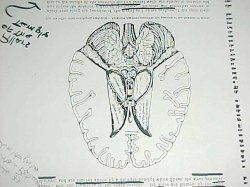Edenists
The two branches of
humanity,
Adamism and
Edenism diverged in
2090 when humans who had
affinity bonds where excommunicated by the
Christian Church. These people are
edenists. The greatest difference between
adamists and
edenists is in their technologies.
Development of Affinity Bond and Memory Transfer
In the early
21st Century much research work was carried out in the field of genetics and biotechnology, leading to the development of quasi-sentient creatures and eventually to the development of intelligent fully sentient creations such as
habitats or
voidhawks. The key to these creations was in their neural nets, brains capable of taking orders from humans.
In
2058 Wing-Tsit Chong developed
affinity symbiont neurons, a revolutionary new method of controlling
bitek creations: using thought commands broadcast by
affinity to implant directions into the
bitek construct.
Affinity could also be used between humans, in a method likened to telepathy people with the
affinity neurons could talk to each other directly using thought.
When
Eden was opened for habitation in
2085 most of the people working there had
affinity, allowing them to interact directly with the
habitat personality.
Wing-Tsit Chong had been heavily involved in the development of
Eden’s genetic structure and when he died in
2090 he revealed another aspect of affinity which had never been considered before: memory transference.
The Start of Edenism
As he died,
Wing-Tsit Chong transferred his memories into
Eden’s
neural strata. Because of the size of
Eden it could easily hold the memories of thousands of people without comprimising its own processing capacity, and people began to realise that there was such a thing as continuation of life after death.
Shortly after
Wing-Tsit Chong’s death
Pope Eleanor declared that what he had done, transfering his memories to the neural structure of
Eden was circumventing divine judgement. She excommunicated all people with
affinity from the
Christian Church.
There was an exodus of
affinity-capable people from
Earth to
Eden. Eventually thousands of
habitats would be grown, all holding people who were practically guaranteed a continuation of life. This exodus signalled the end of
bitek use on
Earthand the technological and theological separation between
adamists and
edenists had begun.
The Growth of the Edenist Society
Eden had been germinated in Jupiter orbit in
2075 to serve as a dormitory town for the mining of
3He from Jupiters atmosphere. When
Eden became independant from the UN it continued this
3He mining.
Because of
affinity,
edenists are perfectly suited for life around
gas giant planets:
Habitats thrive in the magnetosphere of huge planets like
Jupiter. As mankind began to reach out of the
solar system in the
22nd century more and more worlds capable of supporting human life were located. Because of the cost of shipping
3He fuel the presence of a gas giant in the same system as a
terracompatible world became essential, cementing the
edenists’ monopoly on the
3Hemarket.
By the beginning of the
27th century Edenists have germinated thousands of
habitats throughout the
Confederation. The only solar systems which they don’t have a presence in are those owned by the
Kulu Kingdom.
Jupiter has remained the core of
Edenist society, there are 4250
habitats in jovian orbit as of
2611.
Edenist Political Structure
Affinity allows for the greatest stability of political ideologies. When a big decision needs to be made a
consensus is formed. The size of a
consensus depends on the size and scope of the decision to be made — in some cases every
edenist can be consulted. The
consensus is formed using
affinity to link minds with the habitat, allowing every viewpoint to be taken into consideration, making for a truly democratic process.




